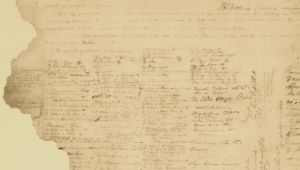Events - 1980s
Te Tiriti o Waitangi
1981 Raglan Golf Course protest
Land taken during the Second World War for a military airfield at Raglan was returned to Tainui Awhiro people, but only after a long dispute. Instead of being handed back to its former owners when not required for its designated public purpose, part of the land was turned into a golf course in 1969. This led Eva Rickard to initiate protest action in the 1970s.
1985 Crown allows claims back to 1840
The Treaty of Waitangi Act was amended, with the Waitangi Tribunal having its powers extended to allow investigation of Crown actions and omissions that could be in breach of Treaty principles dating back to 1840. There were unexpected implications of going back to 1840: opening up the whole history of the terms and modes of colonisation. Researching claims has proved an enormous and specialised task, given the paucity of pre-existing historical work and the level of detail required. The presentation of the claims to the Tribunal and subsequent settlement negotiations with the Crown has also necessitated the involvement of many lawyers and other experts on behalf of both the Crown and the claimants.
1985 Waitangi Tribunal issues reports
An enlarged Waitangi Tribunal issues reports on Treaty claims, including the Motonui-Waitara Report (WAI 6 1983); the Manukau Report (WAI 8 1985); Te Reo Māori Report (WAI 11 1986); the Ōrākei Report (WAI 9 1987); the Muriwhenua Fishing Report (WAI 22 1988); and the Ngāi Tahu Report (WAI 27 1991).
1986 Treaty principles in legislation
The State Owned Enterprises Act was a key piece of legislation to incorporate a reference to the Treaty. Since then, more than 40 statutes have referred (with varying degrees of emphasis) to the principles of the Treaty, in relation to the purpose of the legislation.
1987 Landmark court case
A landmark Court of Appeal case (Māori Council v Attorney-General) established that the Crown must pay heed to previous Maori ownership in disposal of surplus Crown assets such as land. This followed the break-up of old land-holding departments and the establishment of new state owned enterprises under the 1986 State Owned Enterprises Act. That Act declared that the Crown might do nothing 'that is inconsistent with the principles of the Treaty of Waitangi.’ The Court set out a number of principles it saw encapsulated in or derived from the Treaty. Perhaps the key principle was that of partnership, since the Treaty had been signed by two partners. Another was that the Crown, as the more powerful partner, has a duty of active protection of the interests of the weaker partner, Māori.

Related links
The Te Papa Treaty Debates from 2005 up to the present
The annnual Waitangi Rua Rau Tau lecture looks forward to the Waitangi bicentenary in 2040.
External links
- Waitangi Tribunal
- The Office of Treaty Settlements
- Treaty2U Exhibition
- Treaty of Waitangi on NZ History online
- Treaty of Waitangi on Te Ara
Audio
Some of the audio on this page is supplied by Sound Archives Nga Taonga Korero.
NB: All audio on this page is for personal use only. No audio may be posted to a web site, distributed to a third party or broadcast via any means including (but not limited to) radio, television and the internet without the express permission of Radio New Zealand and/or Sound Archives Nga Taonga Korero.